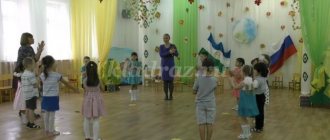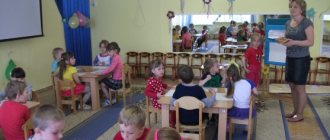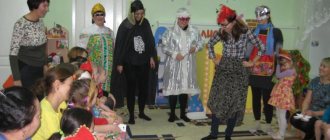Lesson “Autumn Journey” outline of a lesson on speech development (senior group) on the topic
Integrated lesson “Autumn Journey” (speech development + acquaintance with nature + productive activity)
Explanatory note
I decided to conduct the final lesson on the topic “Autumn” in the form of a trip, since I believe that the non-traditional form of conducting educational and game activities with preschoolers, especially speech pathologists, helps create an atmosphere of psychological comfort and interest in children, and relaxed communication between children and adults. In addition, it is precisely when conducting this type of activity that the child’s subjective position is most effectively formed in the types of activity that are most specific to him - play, communication, productive activity. Another feature of our group: the majority of students in it are boys, and for them the active form of the lesson is always interesting. The integrated nature of the lesson was chosen because the tasks of speech development are most effectively solved when they are correctly combined with tasks from other sections of the program aimed at development mental functions and cognitive abilities of preschool children. I used various and, in my opinion, the most effective teaching methods and techniques. The use of an element of TRIZ technology (“Good - Bad”) allowed children to freely express their opinions and justify them. Speech activity and the ability to listen and understand an interlocutor - children acquired these skills in a relaxed manner. The elements of mystery and surprise were not chosen by chance - their role is very important in creating motivation for children's activities, an atmosphere of psychological comfort and active verbal communication. When selecting game exercises and tasks for children, she took into account their different levels of difficulty, assumed different answers from children, and was ready to help children organize productive verbal communication in a timely manner. The use of visuals was carefully thought out by me, because its excess can distract children from active verbal and mental activity, and its deficiency can inhibit curiosity. The pictures were new to the children. Using a practical method - working with a map - diagram effectively solves the problems of developing children's thinking, speech independence and activity. Much has already been said about the importance of exercises for the development of fine motor skills, but to keep children interested, the use of different materials has to be varied. In the context of this lesson, I found the most interesting and appropriate to use plant seeds. Most of the children worked with them for the first time. Nothing limited the freedom of children's imagination, so there was interest and sufficient load for the small muscles of the fingers.
Type of lesson: integrated (speech development + familiarization with nature + productive activity). Purpose of the lesson: to promote the development of speech activity and independence of children, deepen children's ideas about living nature. Program content: Continue to teach children to master forms of speech - reasoning: explanatory speech, speech - proof. To consolidate children’s skills in correctly composing different forms of sentences (simple, complex). Activate in children’s speech words that define natural objects, their qualities and characteristics. Continue to learn correctly, form words using suffixes (baby animals). Practice correct sound pronunciation during speech utterances. Develop children's cognitive abilities, curiosity, logical thinking, imagination. Deepen your understanding of seasonal changes in wildlife in the autumn. Develop fine motor skills, interest in productive activities, and creative imagination. Foster a culture of communication between children (with peers, adults). Cultivate interest in the nature of your native land.
Preliminary work:
- Joint activities: reading works of art about autumn, looking at paintings, guessing riddles, drawing “Autumn”, didactic games, compiling herbariums, targeted walks.
- Independent activity: looking at “Flowers” postcards, looking at encyclopedias.
PROGRESS OF THE CLASS
Educator: Guys, look how many guests we have today, and they don’t know your name. Let's introduce ourselves: smile at each other and affectionately call the person standing next to us by name.
We have an elegant hall, and do you remember what holiday we had here recently? What do you think: is autumn good or bad? (Children's answers)
There's a knock on the door and a magpie flies in
I am a white-sided magpie, I flew from afar, I brought news from the forest. I was strictly told not to forget anything. Autumn left a surprise for you in memory of herself, And the surprise is in the chest, A key on a ribbon. I just forgot where it is: In the closet or on the shelf.
Educator: Guys, the magpie told everything very quickly. Did you understand what she was talking about? ... How will we find a surprise? ...Where is the key? Magpie: I remembered: I was told to tell you to strictly follow all the rules and complete tasks (the magpie gives the children a piece of paper and flies away). Educator: What kind of sheet of paper is this? How do you think? ...Yes, this is a map with which we can find the key. But it says here that in order to get to the key, you only need to follow the road indicated on the map and overcome all obstacles. Do you want to go on a trip? (The teacher invites the children to look at the map and determine the route.) We look at the arrows where we are going.
Music sounds. Here we are in the autumn forest. Do you feel how fresh and clean the forest air is? Let's take a deep breath and straighten our shoulders. What do you hear in the autumn forest? Task 1: “Remove leaves from the path,” but first you need to name what tree this leaf is from and what it is called. (From birch - birch leaf, from aspen - aspen, from poplar - poplar, from rowan - rowan leaf, from oak - oak, from maple - maple). Then we walk along a narrow path. (The teacher invites the children to make an applique from the leaves in the group as a gift for the kids)
Look at the map, where are we heading next? (To the swamp). Can we walk through the swamp? (We go around)
Task 2: The voices of birds are heard
And also tell me - Do you know birds? How are they doing now - Vorobyov, tits?
Look how many birds there are. Think about how they can be divided into two groups. Why did you divide them this way?
Want to play a prank game? Tell me, what's wrong here? Why? Birds flew in: pigeons, tits, flies and swifts. Birds flew in: pigeons, martens, cuckoos, ducks and midges. Birds flew in: pigeons, foxes, storks, starlings. Birds flew in: pigeons, tits, lapwings, siskins, swans and ducks – And thanks for the joke.
Task 3: Dismantle the stones lying on the road in order to move on. (Each stone has an image of an animal)
Many different animals live in the forest. What are their cubs called? Who knows for sure?
Word game "Finish the sentence"
The she-wolf gave birth to ……(cubs) The bear gave birth to club-footed….(cubs) The squirrel has jumping……….(cubs) The fox has cunning………(fox cubs) The hedgehog has born……….(hedgehogs) The elk has…… …(moose calves) The deer has beautiful…….(calves) The hare has fluffy……..(babies) (The teacher arranges pictures of animals in three hoops)
- Bear, hedgehog (they hibernate for the winter).
- Squirrel, hare (change color).
- Wolf, fox, deer, elk (warm undercoat appears by winter)
Why do you think the animals moved into different houses?
The difficulties are all behind us, what will happen ahead?
We found a key and a chest, and in the chest there were seeds of various plants (pumpkin, sunflower, peas, etc.). Do you want to make flowers from seeds to commemorate your autumn trip today? You are ready? And the fingers are not ready yet. First, our fingers will do some gymnastics.
One, two, three, four, five, Children take turns bending their fingers. We will collect leaves. They clench and unclench their fists.
Birch leaves, rowan leaves, Bend your fingers, starting with the thumb. We will collect poplar leaves, aspen leaves, oak leaves, and take an autumn bouquet to Mom. Walk along the left palm with the middle and index fingers of the right hand. Close your eyes and think about what kind of plant you would like to make. Maybe one of you wants to do a job with a friend? Think and agree. The children do the work, while light, calm music sounds
Now let’s play the game “WHEN DOES THIS HAPPEN?” (movable)
- Is the leaf falling?
- Is the rook arriving?
- Is there warm water in the river?
- When will New Year come?
- Does the bear go to bed in its den?
- The snowflake is the first to spin
- Are the days getting shorter?
- Are the sparrows screaming louder?
- Do all the birds fly south?
- Are raspberries ripening in the garden?
- Is there an ice pattern on the windows?
- Are there golden decorations on the birch trees?
- Do they all dig potatoes in their gardens?
- Do they sunbathe under the hot sun?
- When will you all go to first grade together for the first time?
Children's mood. (Visiting the 4 seasons.) Referring to the map.
Did you enjoy today's trip and what did you remember?





